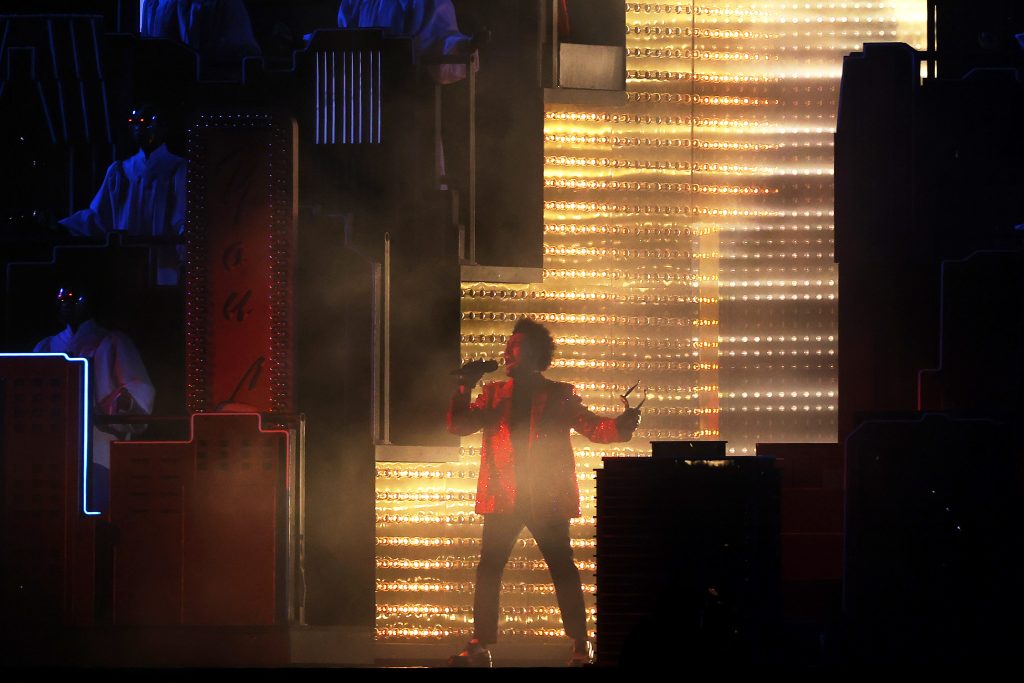Al Gurdon Adds Dramatic Impact to Pepsi Super Bowl LV Halftime Show Lighting with CHAUVET Professional
Posted on March 12, 2021
Photo: Getty Images
TAMPA– No element of design lives in isolation. Each note and every brush stroke must flow in harmony with every other for any creation to achieve its creator’s vision. Al Gurdon demonstrated this at The Weeknd’s Pepsi Super Bowl LV Halftime Show performance as he used 65 CHAUVET Professional Nexus Aw 7×7 panels supplied by PRG to bridge two distinct facets of the show’s design.
Arranged in a tower-like configuration that was revealed when the stands holding The Weeknd’s supporting cast parted into equal sections on either side of them, the Nexus units created a column of intense warm white light that silhouetted the star as he made his first appearance.
In addition to creating a dramatic entrance, the brilliant display of light acted as a bridge between the performance stage that was setup on the North End Concourse at Raymond James Stadium and the backstage hall of mirrors dubbed ‘The Infinity Room’ by the show’s creative team.
“I wanted something that would be powerful enough to create an immediate impact, whilst also offering strong dynamic possibilities,” said Gurdon, whose list of Super Bowl halftime credits includes The Who, Black Eyed Peas, Madonna, and Beyonce. “The Nexus panels did exactly what I had hoped, giving The Weeknd a dramatic entrance and also creating a bridge between the worlds of the stage and the backstage. This was critically important given the size of the show, which comprised both a large set at one end of the stadium and also a large cast on the field of play.”
The analogue feel created by the tungsten-like light of the Nexus fixtures blended nicely with the incandescent glow of the inner set walls and the backstage set. “Having so many incandescent fixtures pushed me toward a colour balance choice I rarely use,” said Gurdon. “I balanced everything to 3600 Kelvin, preventing the tungsten fixtures from reading too yellow, while adding a bit of blue into the outside world. I had been slightly unsure how this would play, with such a variety of lamp types, but in the end, it felt right, especially using the large format cinema-style cameras.”
Following its dramatic opening, the halftime show’s lighting design featured impressive cinematic looks scaled to translate effectively onto the camera, using all of the tools within the lighting rig, smoke and atmospheric effects and seamless coordination with both screen visuals and pyrotechnics.
Drawing on the digital interface of the Nexus units, Gurdon used the fixtures to create dynamic pixel mapped looks at points during the show. “It was definitely good to be able to pixel map without the expense and time-consuming circuiting needed for conventional fixtures,” he said.
Gurdon also sang the praises of his Lighting Team, noting: “Ben Green as my LD has an extraordinary maturity and confidence backed up with thought and experience for someone so young. Jeff Nellis offered sterling support looking after the follow spot balancing and calling. Gaffer Alen Sisul and his team worked tirelessly and cheerfully in the face of difficult weather, especially after the storm which hit Tampa the night before the show. Eric Marchwinski of Earlybird Visual did amazing work as lead programmer both at his pre-viz facility in Los Angeles and on site in Tampa, and was strongly supported by his Earlybird cohorts Mark Humphrey and Nick Coauette. Jason Rudolph programmed screens and was, as always, a cheerful team player with great depth of experience and technical know-how. Emelie Scaminaci, brought in as DOP for her experience with the large format cameras, had a great eye for detail and sensitivity to the lighting process –and finally, Jon Kusner at 22 Degrees provided great help and support as always in putting the team together, and with project management.”
Working in coordination with one another, team members combined their diverse skills and talents to create a smooth, tightly woven halftime show under the unusual circumstances resulting from the pandemic. Much like Gurdon’s lighting design itself, they demonstrated how a powerful creative alchemy can occur when divergent elements are bridged together.